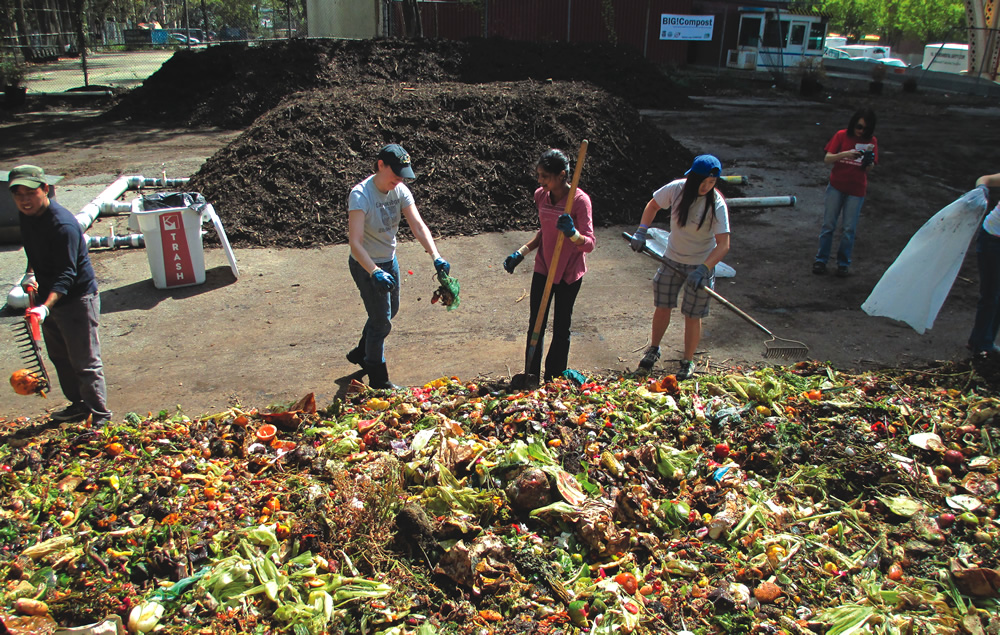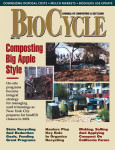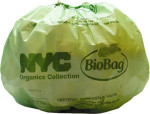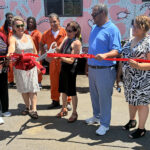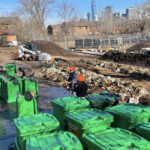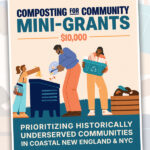Twenty years of investment in neighborhood and small-scale composting operations by the City’s Department of Sanitation yields flourishing movement of community composters. Part I
Nora Goldstein
BioCycle November 2013

BIG! Compost in Western Queens is one of the mid-size community composting operations in New York City. It is part of the NYC Compost Project Local Organics Recovery Program, and processes food scraps from Greenmarkets and drop-off sites, along with yard trimmings, in aerated static piles (aerial photo).
The New York City Department of Sanitation’s (DSNY) Bureau of Waste Prevention, Reuse, and Recycling (BWPRR) created the NYC Compost Project in 1993 to build public understanding and support for local composting initiatives from the ground up. Twenty years later, the program’s success is illustrated by the more than 200 community composting sites and 8 to 10 mid-size operations in the five boroughs —Manhattan, Brooklyn, Queens, Staten Island and the Bronx (Figure 1).
“They range from a single tumbler or 3-bin systems at community gardens to windrows and aerated static piles at some of the medium-scale sites,” says Debbie Sheintoch, Program Manager of BWPRR’s NYC Compost Project. “One of the longest-running programs is the Lower East Side Ecology Center (LESEC) in Manhattan, which started a community composting program in 1990, accepting residential food waste at its community garden on East 7th Street. Today, LESEC has a composting site along the East River where it composts food scraps in in-vessel containers.”
To better understand the role that community composters play on the front-lines of organics recycling in New York City, we interviewed Debbie Sheintoch and Robert Lange, Director of BWPRR, who has witnessed the evolution of composting in New York City for close to three decades.
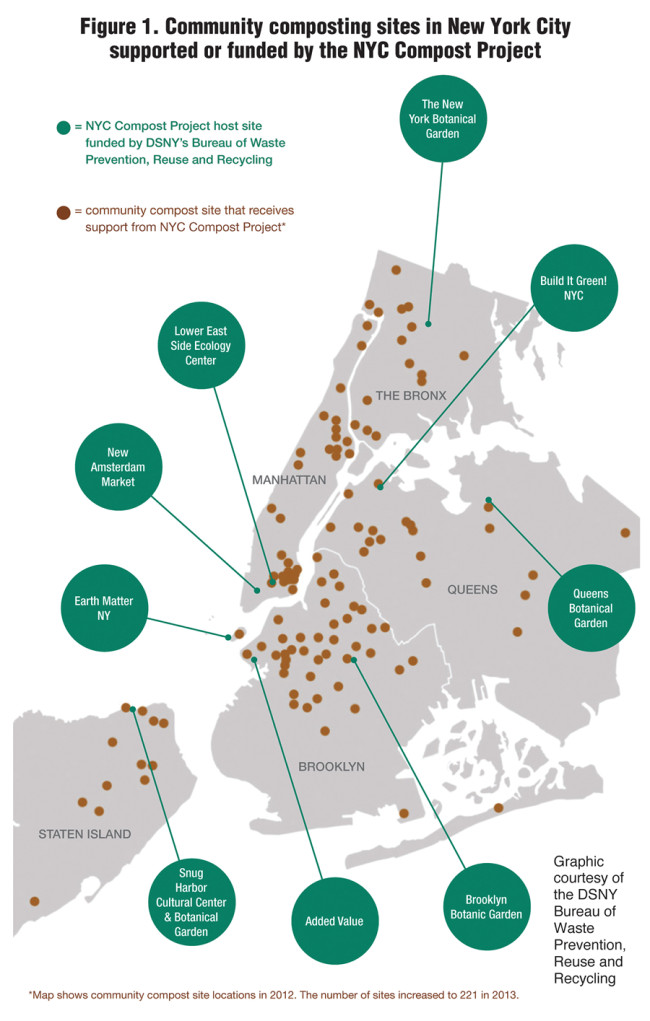
Figure 1. Community composting sites in New York City supported or funded by the NYC Compost Project
BIOCYCLE: In May 1997, BioCycle ran a cover story titled “On-Site Composting, Big Apple Style,” that described various composting programs created by BWPRR. This story included the NYC Compost Project hosted in each borough by that borough’s botanical gardens and in Manhattan, where there is no botanical garden, by the LESEC. It also covered on-site composting of fall leaves at New York City Housing Authority locations throughout the five boroughs as well as Sanitation’s own large-scale composting efforts. What key elements have contributed to the longevity of these programs?
BWPRR: Consistent funding, leadership, and core staff operating the NYC Compost Project at the BWPRR have been essential to the staying power of the Project. We have had a lot of the same very dedicated staff in place for 20 to 25 years. We have a general fund for public education and promotion and a portion of those funds have been used for community composting initiatives since the 1990s.
In addition, the NYC Compost Project may have skirted the typical resetting of agenda initiatives that transpires with each new administration because of its size and cost in comparison to significantly more expensive centralized collection programs. In fact, for the NYC Compost Project, it’s been quite the opposite — consistent and increased funding, and with increased funding, expansion of the scope of programs under the broad programmatic umbrella of the NYC Compost Project.
BIOCYCLE: Our 1997 article highlighted your office’s composting initiatives with New York City’s Botanical Gardens. During our visits to community composting sites in New York City last spring and summer, it is clear that the Botanical Gardens continue to play a critical role in helping advance community composting. What has sustained that relationship over the years?
BWPRR: In the early 1990’s, BWPRR’s conducted a comprehensive backyard composting study to determine if people in NYC with a backyard would compost if they received significant support and technical assistance from the City. Through this study, we found that the constituency most willing to compost were New Yorkers interested in gardening. This is because they understood the benefits of composting and had a use for the finished material. We determined early on that the educational agenda of the botanical gardens and our educational agenda (as it relates to composting and organics management) overlapped sufficiently to partner, especially in terms of training, outreach and education.
Our original findings continue to be true, as the majority of community composting sites we work with are housed in community gardens. Hence, the original NYC Compost Project partnership between BWPRR and the City of New York’s four Botanical Gardens remains intact.
Our Master Composter Certificate Course, held at the City’s Botanical Gardens (as well as at the later added LESEC for Manhattan residents), continues to flourish. The Master Composter Certificate Course is actively attended each Fall and Spring at our host sites and Master Composters go on to lead the way in community composting efforts. Between 2009 and 2012, close to 250 individuals have become certified Master Composters, i.e., they have taken the training and completed at least 30 hours of compost-related community volunteerism within a year after taking the course.
In addition, while the NYC Compost Project primarily began as an educational program, in the last few years it has expanded to include a much larger operational component. NYC Compost Project staff assist local borough based community gardens with managing their composting operations. This includes helping design and build bin and sifter systems and training volunteers — often with the added assistance of Master Composters — on best management practices. We are currently rewriting the curriculum with the Botanical Gardens to make it more relevant to small-scale food waste composting in an urban setting. And, many community gardens have Master Composters managing their on-site composting programs.
BIOCYCLE: What have been highlights of the evolution of community-scale composting in New York City over the past 20 to 25 years?
BWPRR: The original composters in the City of New York were people who had taken over vacant lots. Those people had an interest in creating little islands of green all over the city. It was logistically challenging to improve the soil at these sites, e.g., to get them DSNY Compost or DSNY mulch. Therefore, it was operationally easier and ultimately more sustainable to teach them how to make their own compost. We were ultimately able to support these islands of green by training and linking Master Composters to community gardens in need of technical composting support.
That said, while the original urban composters were gardeners, the more recent applicants to the Master Composter Course are environmentalists who want to compost as a neighborhood-based, solid waste management strategy. These Master Composters often volunteer to create local drop-off and processing sites in their communities. We continue to modify the course as attendees change and new concerns emerge.
At this juncture, we would say that there are three levels of composting in New York City: 1. Backyard and small-scale in community gardens; 2. Medium-scale dedicated composting with higher volumes of organics coming in; and 3. Industrial scale, which DSNY is doing at its Rikers Island facility for food waste and Fresh Kills site for processing yard trimmings with some food waste.
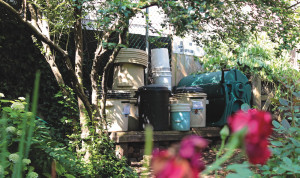
Community gardens are an integral part of the neighborhood composting infrastructure in New York City. (Photo by Nate Clark)
BIOCYCLE: Have you seen more community gardens become interested in composting food scraps?
BWPRR: Community gardens have always taken in household food scraps for composting to make soil for their gardens. But typically, the gardens only want to dedicate a limited portion of their space toward composting. But the medium-scale community composting sector has definitely grown in the last five years, especially as new crops of Master Composters emerge and want to try to process a portion of their neighborhood food waste. We see new, community-based drop-off and processing initiaitves emerging each year through the Master Composter Program.
In addition, the emergence of urban farms, some of which are NYC Compost Project programs, has created a greater demand for more compost. There is also a built in need to process the organics material on-site. We predict that mid-scale composting will grow as urban agriculture develops and grows.
BIOCYCLE: Can you provide more detail about the Local Organics Recovery Program and how that is facilitating residential food waste diversion?
BWPRR: The Local Organics Recovery Program (LORP) is the programmatic name for the operations component of the NYC Compost Project. Originally, the NYC Compost Project focused on compost outreach, education and technical assistance. However, as interest in neighborhood-based composting grew, we launched LORP in the spring of 2012 to provide residents with a wider range of food scraps drop-off opportunities and to ensure that those food scraps were composted locally.
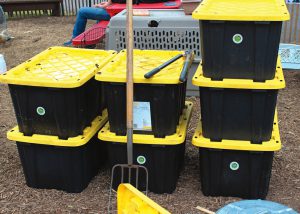
Food scraps collected at the Greenmarkets are transported to mid-size community composting sites in containers.
3Groups funded to run the LORP program of the NYC Compost Project develop, grow and service neighborhood-based food scraps drop-off sites. All LORP drop-off sites are posted on our website. Some are at Greenmarkets but others are at libraries, specialty food markets, or other neighborhood locations. The program also boasts commuter composting drop-off locations, where we have “pop-up” drop-off sites at subway stations. We have seen growing interest, especially among younger people, to divert their food scraps. Our goal is to make it easier for people to participate. In turn, this increases the flow of food scraps to New York City’s community composters.
Community-based composting operations in the LORP program, as well as other decentralized sites in New York City such as the Gowanus Canal Conservancy in Brooklyn (as well as community gardens), have enabled us to manage a significant portion of the food scraps from the Greenmarkets within New York City. When the Greenmarket program was launched, food scraps were hauled to Peninsula Compost in Wilmington, Delaware, about 130 miles one-way. We decided as an agency that it made sense to develop composting capacity for those materials in New York City. All the LORP facilities do their own collection of the Greenmarket food scraps that they process. And they also service community events.
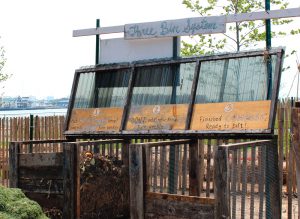
Earth Matter, a NYC Compost Project Local Organics Recovery Program site on Governor’s Island, also serves as an educational facility that highlights various composting methods (including 3-bin system).
The most recent expansion within the LORP program is at the Lower East Side Ecology Center’s composting site along the East River, which composts food scraps in small, aerated vessels. Twelve more in-vessel containers are being added.
BIOCYCLE: What criteria does BWPRR use to select composting sites for LORP?
BWPRR: BWPRR’s LORP partners are all nonprofit organizations that have demonstrated their longevity and have the capacity to grow. The operators all have experience in composting food scraps in a dense urban setting. Most of the operators are graduates of our Master Composter program. LORP sites are all registered composting facilities with the New York State Department of Environmental Conservation (NYSDEC), and have approval to operate on the sites where they are located. These facilities are not taking in commercial material. LORP staff complement the initiatives we operate out of the Botanical Gardens.
BIOCYCLE: As New York City increases its pilot programs for curbside residential collection of food scraps, what role will community composters play in managing organic waste streams?
BWPRR: From a solid waste management perspective, community composting is not a solution to food waste management in New York City. However, there is still a place for these kinds of operations. We will always have a subset of the population that wants to keep their food waste totally separate and totally clean and are willing to drop their food scraps off locally for neighborhood composting. Those who opt in for this kind of system take heart in knowing that their food waste will ultimately be utilized for neighborhood greening projects or in a local community garden.
We are thrilled to be on the cutting edge of community composting and want to help bridge the links between all parties engaged in food production, consumption and recycling.


